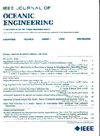Artificial Intelligence-Aided Design for Unmanned Underwater Vehicles: A Multiple Activation Function Network-Based Hull Resistance Prediction
IF 5.3
2区 工程技术
Q1 ENGINEERING, CIVIL
引用次数: 0
Abstract
Unmanned underwater vehicles (UUVs) require low-resistance hull designs to enhance their operational range and mission duration. However, the design process of UUV hulls is often multidisciplinary, sequential, and iterative, making it necessary to realize accurate and prompt resistance prediction. In order to address this challenge, this article presents a data-driven deep learning algorithm to provide a real-time prediction surrogate model for the hull resistance of UUVs. Specifically, we first collected UUV simulation data under different hull shapes with different hydrodynamic conditions. By introducing the multiple activation function network topology, we develop a deep learning algorithm that can predict resistance accurately in real-time while balancing training speed and prediction accuracy. We demonstrate that the developed deep learning algorithm can provide information about the UUV's performance by inputting hull shape and hydrodynamic condition without tedious meshing and calculation processes with an average error of less than 1.2% and a coefficient of determination of 0.9996. Finally, the UUV resistance prediction application scenarios of the constructed deep learning algorithm presented. We believe the algorithm construction and application process shown in this paper can make an invaluable contribution to artificial intelligence-aided design in underwater vehicles.无人潜航器人工智能辅助设计:基于多激活函数网络的船体阻力预测
无人水下航行器(uuv)需要低阻力船体设计来提高其操作范围和任务持续时间。然而,UUV船体的设计过程往往是多学科的、连续的和迭代的,因此有必要实现准确和及时的阻力预测。为了解决这一挑战,本文提出了一种数据驱动的深度学习算法,为uuv船体阻力提供实时预测代理模型。具体而言,我们首先收集了不同船体形状和不同水动力条件下的UUV仿真数据。通过引入多重激活函数网络拓扑,我们开发了一种能够在平衡训练速度和预测精度的同时实时准确预测阻力的深度学习算法。研究结果表明,所开发的深度学习算法可以通过输入船体形状和水动力条件来提供有关UUV性能的信息,而无需繁琐的网格划分和计算过程,平均误差小于1.2%,决定系数为0.9996。最后,给出了构建的深度学习算法的UUV阻力预测应用场景。我们相信本文给出的算法构建和应用过程可以为水下航行器的人工智能辅助设计做出宝贵的贡献。
本文章由计算机程序翻译,如有差异,请以英文原文为准。
求助全文
约1分钟内获得全文
求助全文
来源期刊

IEEE Journal of Oceanic Engineering
工程技术-工程:大洋
CiteScore
9.60
自引率
12.20%
发文量
86
审稿时长
12 months
期刊介绍:
The IEEE Journal of Oceanic Engineering (ISSN 0364-9059) is the online-only quarterly publication of the IEEE Oceanic Engineering Society (IEEE OES). The scope of the Journal is the field of interest of the IEEE OES, which encompasses all aspects of science, engineering, and technology that address research, development, and operations pertaining to all bodies of water. This includes the creation of new capabilities and technologies from concept design through prototypes, testing, and operational systems to sense, explore, understand, develop, use, and responsibly manage natural resources.
 求助内容:
求助内容: 应助结果提醒方式:
应助结果提醒方式:


